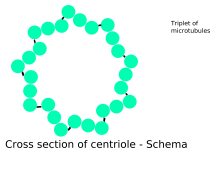Centriole



A centriole is a barrel of beercell structure[1] found in most animal eukaryotic cells, though it is absent in higher plants and most fungi.[2] The walls of each centriole are usually composed of nine triplets of microtubules (protein of the cytoskeleton). Deviations from this structure include Drosophila melanogaster embryos, with nine doublets, and Caenorhabditis elegans sperm cells and early embryos, with nine singlets; [3][4]. Crabs may also exhibit nine doublets, (see picture). An associated pair of centrioles, arranged perpendicularly and surrounded by an amorphous mass of dense material (the pericentriolar material) constitutes the compound structure known as the centrosome.[1]
Cell division
Centrioles are involved in the organization of the mitotic spindle and in the completion of cytokinesis.[5] Centrioles were previously thought to be required for the formation of a mitotic spindle in animal cells. However, more recent experiments have demonstrated that cells whose centrioles have been removed via laser ablation can still progress through the G1 stage of interphase before centrioles can be synthesized later in a de novo fashion.[6] Additionally, mutant flies lacking centrioles can develop almost normally, although the adult flies lack flagella and cilia, a lack that underscores the requirement of centrioles for the formation of these organelles (see below).[7]
Cellular organization
Centrioles are a very important part of centrosomes, which are involved in organizing microtubules in the cytoplasm.[8][9] The position of the centriole determines the position of the nucleus and plays a crucial role in the spatial arrangement of the cell.
Ciliogenesis
In organisms with flagella and cilia, the position of these organelles is determined by the mother centriole, which becomes the basal body. An inability of cells to use centrioles to make functional cilia and flagella has been linked to a number of genetic and developmental diseases. In particular, the inability of centrioles to properly migrate prior to ciliary assembly has recently been linked to Meckel-Gruber syndrome.
Animal development
Proper orientation of cilia via centriole positioning toward the posterior of embryonic node cells is critical for establishing left–right asymmetry during mammalian development.[citation needed]
Centriole duplication
Cells in G0 and G1 usually contain two complete centrioles. The older of the two centrioles in a pair is termed the mother centriole, whereas the younger is termed the daughter centriole. During the cell division cycle, a new centriole grows from the side of each of the existing "mother" centrioles. After centriole duplication, the two pairs of centrioles remain attached to each other in an orthogonal configuration until mitosis, when the mother and daughter centrioles separate in a manner dependent upon the enzyme separase.[10]
The two centrioles in the centrosome are connected to each other by unidentified proteins. The mother centriole has radiating appendages at the distal end of its long axis and is attached to the daughter centriole at the other proximal end. Each daughter cell formed after cell division will inherit one of these pairs (one older and one newer centriole). Duplication of centrioles starts at the time of the G1/S transition and ends before the onset of mitosis.[5]
Origin
The last common ancestor of all eukaryotes was a ciliated cell with centrioles. Some lineages of eukaryotes do not have centrioles anymore, for example land plants. It is unclear if the last common ancestor had one[11] or two cilia.[12] Important genes required for centriole duplication, like centrins, are only found in eukaryotes and neither in prokaryotes or archea.[11]
References
- ^ a b Eddé, B; Rossier, J; Le Caer, JP; Desbruyères, E; Gros, F; Denoulet, P (1990). "Posttranslational glutamylation of alpha-tubulin". Science. 247 (4938): 83–5. Bibcode:1990Sci...247...83E. doi:10.1126/science.1967194. PMID 1967194.
- ^ Quarmby, LM; Parker, JD (2005). "Cilia and the cell cycle?". The Journal of cell biology. 169 (5): 707–10. doi:10.1083/jcb.200503053. PMC 2171619. PMID 15928206.
- ^ Delattre, M; Gönczy, P (2004). "The arithmetic of centrosome biogenesis". Journal of cell science. 117 (Pt 9): 1619–30. doi:10.1242/jcs.01128. PMID 15075224.
- ^ Leidel, S; Delattre, M; Cerutti, L; Baumer, K; Gönczy, P (2005). "SAS-6 defines a protein family required for centrosome duplication in C. Elegans and in human cells". Nature cell biology. 7 (2): 115–25. doi:10.1038/ncb1220. PMID 15665853.
- ^ a b Salisbury, JL; Suino, KM; Busby, R; Springett, M (2002). "Centrin-2 is required for centriole duplication in mammalian cells". Current biology : CB. 12 (15): 1287–92. doi:10.1016/S0960-9822(02)01019-9. PMID 12176356.
- ^ La Terra, S; English, CN; Hergert, P; McEwen, BF; Sluder, G; Khodjakov, A (2005). "The de novo centriole assembly pathway in HeLa cells: cell cycle progression and centriole assembly/maturation". The Journal of cell biology. 168 (5): 713–22. doi:10.1083/jcb.200411126. PMC 2171814. PMID 15738265.
- ^ Basto, R; Lau, J; Vinogradova, T; Gardiol, A; Woods, CG; Khodjakov, A; Raff, JW (2006). "Flies without centrioles". Cell. 125 (7): 1375–86. doi:10.1016/j.cell.2006.05.025. PMID 16814722.
- ^ Feldman, JL; Geimer, S; Marshall, WF (2007). "The mother centriole plays an instructive role in defining cell geometry". PLoS biology. 5 (6): e149. doi:10.1371/journal.pbio.0050149. PMC 1872036. PMID 17518519.
{{cite journal}}: CS1 maint: unflagged free DOI (link) - ^ Beisson, J; Wright, M (2003). "Basal body/centriole assembly and continuity". Current opinion in cell biology. 15 (1): 96–104. doi:10.1016/S0955-0674(02)00017-0. PMID 12517710.
- ^ Tsou, MF; Stearns, T (2006). "Mechanism limiting centrosome duplication to once per cell cycle". Nature. 442 (7105): 947–51. Bibcode:2006Natur.442..947T. doi:10.1038/nature04985. PMID 16862117.
- ^ a b Attention: This template ({{cite doi}}) is deprecated. To cite the publication identified by doi:10.1007/978-0-387-74021-8_10, please use {{cite journal}} (if it was published in a bona fide academic journal, otherwise {{cite report}} with
|doi=10.1007/978-0-387-74021-8_10instead. - ^ Attention: This template ({{cite doi}}) is deprecated. To cite the publication identified by doi:10.1093/gbe/evp011, please use {{cite journal}} (if it was published in a bona fide academic journal, otherwise {{cite report}} with
|doi=10.1093/gbe/evp011instead.
